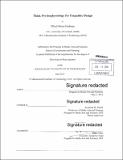Thick psychophysiology for empathic design
Author(s)
Hedman, Elliott B. (Elliot Bruce)
DownloadFull printable version (21.81Mb)
Other Contributors
Massachusetts Institute of Technology. Department of Architecture. Program in Media Arts and Sciences.
Advisor
Rosalind W. Picard.
Terms of use
Metadata
Show full item recordAbstract
Over the course of six years, I brought ambulatory psychophysiology into a variety of industries as a means of conducting design research. I looked at the stress of children in occupational therapy, the frustration of playing Hasbro board games, the thrill of driving a Google Self Driving Car, the confidence of shopping at Best Buy and Lowes, the excitement of playing LEGO Technic for the first time, the tension of watching one's first symphony, and the anxiety of talking about birth control. Working with stake holders within these settings I developed "Thick Psychophysiology," defined by four characteristics: 1. Psychophysiological data is quantitatively measured, 2. The research answers explorative, open ended questions, 3. The research measures external context, and 4. The research measures internal context. By combining ethnographic methods with psychophysiology, researchers can address the challenges of specificity that ambulatory, explorative research produces. Two case studies of preliminary design research are provided about the LEGO Group and the New World Symphony, showcasing how thick psychophysiology can help uncover customer's unarticulated needs. Once needs are uncovered, the challenge is how to motivate an organization to address those needs. Traditionally, designers use storytelling as a way to communicate research findings in regards to user experience, which in some cases can be ineffective in creating the needed motivation. The method developed in this thesis contains components designed to help influence organizational change. To test the effect psychophysiological data can have on organizational change, I delivered a survey testing four ways (conditions) of presenting findings: Storytelling (the most common method used by companies such as IDEO), Video-based (adding video to the story), and two conditions using Video and psychophysiology, varying how the physiological insights were presented (narrow vs. broad). Participants in the broad condition were told the skin conductance could mean a variety of things including moving, breathing hard, being stressed, or being excited. We analyzed the results of 143 LEGO employees. Participants in the broad skin conductance condition had a 47% chance of increasing the priority of the proposed initiative, whereas only 9% of participants in the storytelling condition increased the priority of that initiative (p<0.0 1). Post hoc analysis showed that when participants reported an empathic response to the skin conductance, they were even more likely to increase the priority of that broad skin conductance initiative (75%). These results suggest that, when compared to storytelling, presenting psychophysiological data can be a more effective way to communicate customer experience.
Description
Thesis: Ph. D., Massachusetts Institute of Technology, School of Architecture and Planning, Program in Media Arts and Sciences, 2014. Cataloged from PDF version of thesis. Includes bibliographical references (pages 147-155).
Date issued
2014Department
Program in Media Arts and Sciences (Massachusetts Institute of Technology)Publisher
Massachusetts Institute of Technology
Keywords
Architecture. Program in Media Arts and Sciences.